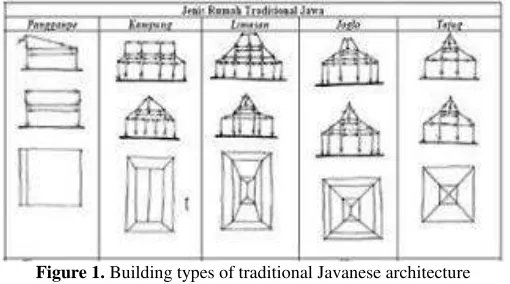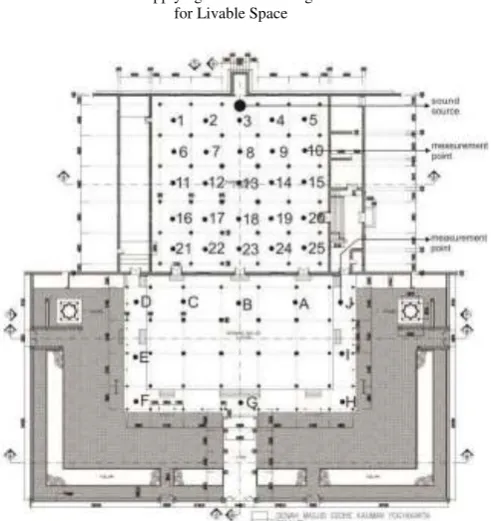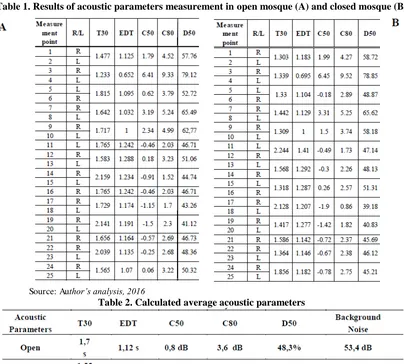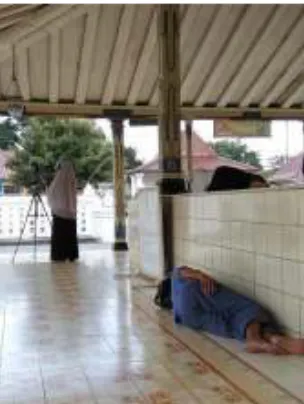APPLICATION OF LOCAL KNOWLEDGE IN MASJID AGUNG
YOGYAKARTA FOR A GOOD ACOUSTICS QUALITY
Nur Rahmawati Syamsiyah1, Atyanto Dharoko2, Sentagi Sosetya Utami3
1
Architecture Department of Engineering Faculty, Muhammadiyah University of Surakarta, INDONESIA, e-mail: [email protected]
2Architecture Department of Engineering Faculty, Gadjah Mada University of Yogyakarta, INDONESIA,
e-mail:[email protected]
3Physics Department of Engineering Faculty, Gadjah Mada University of Yogyakarta, INDONESIA,
e-mail: [email protected]
ABSTRACT
Local knowledge could not be separated from the culture of the people who created it. The study of culture as knowledge derives from the ideas that are explored continuously and constantly applied through the attitudes, behaviors, and actions of the people in order to produce artifacts. Local knowledge of Javanese architecture represents a great philosophy. It comes from the Javanese way of life, the Javanese construction of the house and its surroundings, and the Javanese harmony and balance among the self, the nature, and the needs of God. A real mosque as a 'dwelling' requires comfortable conditions. The architecture of mosques is the result of constant dialogue between human being and the environment. The architecture should be in accordance with the needs of human being on the environment, including tranquility space while praying in the mosque. From local knowledge point of view, mosque is the most dignified building; it has its specific design. The proportion of shape, of roof, of columns, of floor, and of foyer exerts particular size in line with local knowledge in order to create quietness and audio comfort. Therefore, the mosque is highly expected to be a place for worship in a good acoustic quality as can be physically proved through the Grand Mosque of Yogyakarta. It has equipped with high-quality level of sound clarity, good clarity of speech, and appropriate level of reverberation which have met its standards procedure.
Keywords: acoustic quality; local knowledge; mosque
ABSTRAK
Pengetahuan lokal tak lepas dari budaya orang-orang yang mendukungnya. Studi budaya sebagai pengetahuan berasal dari ide-ide yang dieksplorasi terus menerus dan diterapkan dalam sikap, perilaku dan tindakan untuk menghasilkan artefak. Pengetahuan lokal arsitektur Jawa memiliki filosofi yang tinggi. Hal ini berasal dari cara hidup orang Jawa di rumah dan sekitarnya, yaitu harmonisasi dan keseimbangan antara diri, alam dan kebutuhan akan Tuhan (Allah). Sebuah masjid yang nyata sebagai 'tempat tinggal' sangat membutuhkan kondisi yang nyaman. Arsitektur masjid adalah hasil dari dialog antaramanusia dan lingkungan. Arsitektur harus sesuai dengan kebutuhan manusia terhadap lingkungan, termasuk ruang ketenangan saat berdoa di masjid. Masjid dalam pengetahuan lokal adalah bangunan paling mulia dan memiliki karakteristik desain. Proporsi bentuk bangunan, bentuk atap, layout atau tata letak kolom, rencana lantai dan ruang foyer ada dalam ukuran tertentu berdasarkan pengetahuan lokal. Hal ini membuat ketenangan dan kenyamanan audial, sehingga masjid sangat diharapkan untuk menjadi tempat ibadah dalam kualitas akustik yang baik. Masjid Agung Yogyakarta sudah terbukti secara fisik telah memberikan kualitas akustik yang baik. Tingkat kejernihan suara, kejelasan berbicara, dan waktu dengung seluruhnya memenuhi standar.
Kata kunci: kualitas akustik; pengetahuan lokal; masjid
1. INTRODUCTION
1.1. Local knowledge based on community awareness of their abilities
where they live. There are four components that unite the close relationship, that are trust, knowledge, social ethics, and aesthetics. Javanese community believes that they live among the four powers, namely spiritual, magical, macrocosmic, and microcosmic. Humans are in the midst of the mighty power of God and the forces of nature (the vertical axis), and between the power of human life itself and the power of his spirit (the horizontal axis).
1.2. Traditional architecture
Generally, traditional architecture is constructed upon local knowledge and cultural knowledge of local community, as in the case of Javanese traditional architecture. Its concept comprises beliefs and rituals that appear to be closely related to both the space orientation and the space configuration. Even several functional buildings besides residential buildings have detail structure and construction rules. One Javanese traditional architecture concept is known as petungan. It contains measurement and calculation of the parts of building, especially the length-width dimension, pillars height, and the number of usuk (rafter). In addition, it also contains the ratio and proportion in architecture (Josef Prijotomo, 1995). There are a lot of evidences supporting the fact that space in Javanese traditional architecture is not value-free.
In traditional Javanese architecture, 5 types of buildings are known (Figure 1); mosque, joglo, limasan, kampung and panggang-pe. Each type has a number of different variants. Mosque has only two variants, tajug and langgar. The characteristics of the other 4 types building and their variants are on the number, shape, and length of wood construction of the roof and pillar. Mosque has cylindrical pillars. This shape distinguishes mosques from other types of buildings which pillars are rectangular. According to the local knowledge of Javanese community, the four types of buildings were developed from the basic type, namely the mosque, especially of tajug variant. The developments were in the types of roof, preceded by tajug, then joglo (from the word tajug-loro), then the limasan (from the word liman sap), and lastly kampung. The last type arises due to shortage, so it emphasizes simplicity in making roof (Josef Prijotomo, 1995, p. 11).
Figure 1. Building types of traditional Javanese architecture
Source: http://sketsasenja.blogspot.co.id/2011/10/kajian-historis-morfologi-masjid-agung_06.html
The important thing in traditional Javanese architecture is about structural system of the building. There are two systems of building structures, namely the room plan and the roof plan. Building plans emphasize length and width of the room and layout of the building reinforcing pillars. The proportion of building is not only physically determined by size but also by the characteristics or pewatakan desired by the building owner. Awareness to bring good proportions through disposition is adapted to the type of building. Disposition is taken from the length of the building, the pole height, and the number of rafters. There are several terms in disposition, such as sri (knowledgeable character), tapa (tempered hunger), lungguh (solid character), sedana (rich character), and pugeran (trustworthy and steadfast character).
The ratio of length to width of main room plan in four types of building is as follows: Masjid type length : width = 1 : 1
Joglo type length : width = 3 : 2 Limasan type length : width = 5 : 3 Kampung type length : width = 2 : 1
1.3. The Grand Mosque of Yogyakarta as a traditional mosque
Grand Mosque of Yogyakarta, better known as Masjid Gedhe Kauman, was built by Sri Sultan Hamengku Buwono I and Kyai Faqih Ibrahim Diponingrat (the first religious leader of Yogyakarta Palace), as well as Kyai Wiryokusumo as the architect. The mosque was built on Wage (Javanese day) Sunday, May 29th 1773 AD or 6 Robi'ul Akhir 1187 Hijriyah (Islamic calendar). Grand Mosque of Yogyakarta is a central mosque that was built in the center of Ngayogyakarta Sultanate. The mosque, standing in the main square north of Yogyakarta, is one of the national heritage building as stated in Monumenten Ordonante 238/1931 and preserved by the Indonesian Government.
This study was conducted in the traditional mosque as a cultural heritage of high historical value and is a conserved building in accordance to DIY (Yogyakarta special province) Governor Decree No. 186 / 2011. Figure 2 shows several parts of the Grand Mosque complex in Yogyakarta.
Figure 2. Several parts of the Grand Mosque complex in Yogyakarta
Source: Author‘s document, 2015
Yogyakarta Grand Mosque was built on an area of 16,000 square meters with building area of 2,578 square meters. This mosque can accommodate up to 1,500 worshipers. The mosque is still standing strong since it was built, except for the foyer (serambi) of the mosque that experienced redevelopment in 1867 by Sultan Hamengku Buwono VI because of the earthquake that tore it down. Spacious foyer is now two times the size before the earthquake hit. In 1933 shingle roof was replaced with thick and strong wiron (wavy) zinc plate. The walls of the mosque were made of white stone structure that still survive until now. The original mosque floor was made of black stone. Initiated by the Sultan Hamengku Buwono VIII, the floor of foyer and mosque was replaced with Italian marble, respectively in 1933 and 1936. The foyer is still used as a place of prayers and Islam-related rituals. The mosque became the object of research as this research is expected to reveal that the acoustic phenomena in it as part of intangible cultural heritage.
2. METHODOLOGY
In general, there are two kinds of research paradigms, namely qualitative and quantitative. Research paradigm is the view towards the research object, which will affect the research method to be used. To choose the right paradigm in research, it is necessary to understand the character of research to be conducted. The study of The Grand Mosque of Yogyakarta has the following characteristics:
of worship activities like prayer, community education, scientific assemblies, Islamic studies, and other activities as muamalah (community-related) worship activities. Thus, the mosque is assumed to have a good level of audial comfort.
b. The Grand Mosque of Yogyakarta as a research object is a traditional mosque. In the past, the construction of mosques followed the rules of traditional buildings as local knowledge. The mosque is pristine except for the floor and roof.
c. The research activities are acoustic measurements by instrument, followed by the interpretation of measurement results through observation and interviews with users of the mosque
Considering these characters of the study, the research paradigm chosen is of rationalistic one, as a consequence of the existing problem and research character. Results to be generated will not only be sensible empirics but also logical empirics. Acoustical phenomenon is a physical phenomenon, so that the analysis used a research methodology that put hypothesis proving as the first step. To prove the hypothesis, impulse response was measured to look for acoustic parameters and soundscape measurement. Nevertheless, the results still require interpretation to reveal the truth behind physical phenomena as the cause of acoustic phenomena formation. Interpretation of results was also conducted using non-physical phenomena, which include history, as well as religious and cultural activities of local communities associated with the mosque. Therefore, linkages between acoustic phenomena and local knowledge of local community who built the mosque will be revealed. This research combined quantitative and qualitative approaches. Quantitative research was conducted through objective acoustic measurements, then the results will be interpreted in a descriptive qualitative manner. Sugiyono (2012) found that quantitative and qualitative methods which are used simultaneously will obtain more comprehensive, valid, reliable, and objective data.
2.1. Quantitative Method
Quantitative methods in this acoustics research emphasis on measuring the impulse response. Measurement of impulse response essentially aims to find the value of acoustic parameters. From these measurements, we will get an overview of interaction between the sound source with indoor surfaces. It can be described in a time sequence pattern of reflected sound energy at any point in the room, as well as the reduction of sound energy at any time or any information of reflected sound (Yanti, 2014). Acoustic parameters in this study consist of; reverberation time (RT or T), Early Decay Time (EDT), Clarity of speech or Definition (D), Clarity of discussion or Clarity (C) and Background noise.
The dependent variable in quantitative method is acoustic parameter, whereas the independent variable is building and environmental setting of the mosque indoor. Supporting instruments of quantitative method are: Dodecahedron sound source; Omnidirectional microphone; Calibrator; Amplifier; Signal conditioning system; Laptop with installed software of Realtime Analyzer (Yoshimasa-Japan); Tripod and connecting cables. The main instrument of measuring tools are shown in Figure 3.
Figure 3. The main measuring tools (from left to right): omnidirectional microphone, omnidirectional dodecahedron, tools setting, amplifier, and signal conditioning system ; Source: Author‘s document, 2015
Figure 4. Pattern of microphone positions or measurement points
Source: Author‘s analysis, 2016
The retrieval of data used realtime analyzer software (Yoshimasa, Japan). Realtime analyzer is one of the software to process the measurement results of indoor acoustic parameters. After retrieval, the RTA performed signal processing that produced acoustic parameters. The frequency range was read on the graph as impulse response of 63 Hz to 16,000 Hz and 1/3 octave filter. The data were analyzed at the middle octave band frequency range of 1000 Hz in 1/3 octave bands, so the data was retrieved in the range of 890.899 Hz - 1122.462 Hz.
2.2. Qualitative Method
Instrument for qualitative methods are researchers themselves. Results of quantitative methods need to be interpreted using subjective qualitative methods. Qualitative methods emphasize the user's perception of the condition of the mosque space and the activities in it. A questionnaire was used as a measuring tool for subjective evaluation. A list of questions used was related to the comfort of hearing, speech intelligibility, clarity of discussion, the clarity of the sound, and the selection of the most convenient places to pray and listen to imam/khatib (preacher).
2.3. The Standard of acoustic parameters
Reverberation time (T30) as standardized by Mullan (1992) is 1.5 until 1.8 seconds, by Mediastika (2005) is 0.5-1.5 seconds. Kayili (2005) standardized T30 based on the volume of space, so for this mosque of 7,100 m3 T30 is 2.1 seconds. The standard of speech clarity (chosen for prayer) is C50>0 dB (Long, 2006), while standard of music clarity (chosen for Holy Qur'an recital) is 0<C80<4 dB (Long, 2006, p. 637), with +3< C80 <+8 for the front row and 0< C80 <+5 for the back row. Standard of excellent 90-97% definition is 45 <D50 <70 (Mc Mullan in Mediastika, 2005). Standard of Early Decay Time for speech room is 0.648 – 0.81 second. There is no standard of background noise, but in general the standard is 30-35 dB (Kinsler, et al., 2000, p. 364).
3. DISCUSSION
3.1. Traditional architecture supports for the formation of acoustic quality
architecture, because it maintains the values of traditional Javanese philosophy until today. The existence of the mosque needs to be studied further, especially about the inside acoustic conditions. There is an assumption that it was built by the influence of not only Javanese petungan but also the characters of Sultan Hamengku Buwono I. It can be understood because the Sultan had an architectural expertise. He might not have thought about the acoustic quality yet, since at that time there was no sound system available and only the human voice was concerned. It was quite enclosed within the construction system of mosques. Now it is easier to set up the acoustic quality with modern sound system.
3.2. Acoustic parameters measurement
This research used real sound impulses without sound systems, or in other word natural sound. Sound impulses from the dodecahedron loudspeaker will produce high and low frequency distribution and the value of acoustic parameters of each frequency. Acoustic parameter values obtained demonstrate the performance of the building elements that exist in the main hall of the mosque.
Impulse response measurement was conducted at 07.30 until 11.30 a.m. local time. This is the noisiest time because usually the courtyard of the mosque is used for sports activities by Kauman Muhammadiyah elementary school students. Children's activities are the source of noise. After the measurement was done, a stage entertainment was ongoing in the north of the square. This was also the source of the noise. These noises did not affect the tranquility in the mosque. It is proved by the results of acoustic parameters measurements in Table 1 and calculated average acoustic parameters as listed in Table 2. The reverberation time, definition, sound clarity, and background noise demonstrate compliance with their standards.
Table 1. Results of acoustic parameters measurement in open mosque (A) and closed mosque (B)
Source: Author’s analysis, 2016
Table 2. Calculated average acoustic parameters
Figure 5. Iso-acoustic of sound pressure level in open mosque (A) and closed mosque (B)
Source: Author‘s analysis, 2016
The opening and closing of mosque grand hall show similar sound patterns. The front part of the mosque had a low sound pressure which noiseless space is only 39 dB, while the middle reached 53 dB, and near the rear entrance reached 58 dB. Background noise measurement results in the main hall of the mosque has an average value of 52.5 dB.
Worshipers inside the mosque (36 male respondents aged 20-65 years) mostly prefer noiseless spaces in the front (66.7%) than in the middle (33.3%). Generally respondents felt the mosque is quiet and the preacher‘s voice was clear (95%). Women (5%) were provided spaces in the back and so felt less quiet for their prayers near the entrance. Based on the results of questionnaires, it appears that the mosque can still provide comfortable "dwelling" for worshippers to stay for long time. The mosque that was built upon Javanese traditional architecture and has a history of noble values, turns out to save the deep meaning of a comfortable space to live in.
The soundscape measurement was also conducted in the foyer of the mosque. The sound pressure level in the north side of the foyer is 48 dB. Figure 5 shows that the foyer of the mosque had a regular iso-acoustic pattern like the grand hall. Noises around the mosque did not affect the comfort of worshippers for long stay in the foyer. Even they could comfortably and peacefully rest and sleep there, waiting for prayer time (Figure 6). In the front portico surrounding the mosque there is a fountain which increases the relaxed and restful feeling of the worshippers as they hear the sound of gurgling water.
Figure 6. The north side of foyer forming a relaxed and restful place
4. CONCLUSION AND RECOMMENDATION
Yogyakarta privilege lies not only in the form of government, but also the privilege of Yogyakarta geoecology and noble values of society that must be well-maintained. Local knowledge on the architecture of Javanese community has provided a clear evidence that it has noble values. The Grand Mosque of Yogyakarta is a proof that local knowledge about the proportions of the building shapes, dimensions, as well as number of pillars and rafters, had formed comfortable inside and outside spaces for worship. The mosque has good acoustic qualities. Acoustic parameters of sound clarity, speech clarity, and reverberation time were in accordance with their standard. Inside space in the mosque was shaped to allow quietness for worship with more concentration. The outside space was formed in order for worshipers to feel comfortable and relax for a long stay to worship in the mosque.
REFERENCES
1) Josef Prijotomo, M. R. (1995). Petungan, Sistem Ukuran dalam Arsitektur Jawa. Yogyakarta: Gadjah Mada University Press.
2) Kayili, M. (2005). Acoustic Solutions in Classic Ottoman Architecture. Manchester: Aasiya Alla FSTC Limited.
3) Kinsler, L. (2000). Fundamentals of Acoustics. USA: John Wiley & Sons Inc. Hamilton Press. 4) Long, M. (2006). Architectural Acoustics. Burlington; California; London: Elsevier Academic Press. 5) Mediastika, C. E. (2005). Akustika Bangunan, Prinsip-prinsip dan Penerapannya di Indonesia. Jakarta:
Erlangga.
6) Mullan, R. M. (1992). Environmental Science in Building. London: Macmillan.
7) Ronald, A. (2005). Nilai-nilai Arsitektur Rumah Tradisional Jawa. Yogyakarta: Gadjah Mada University Press.





